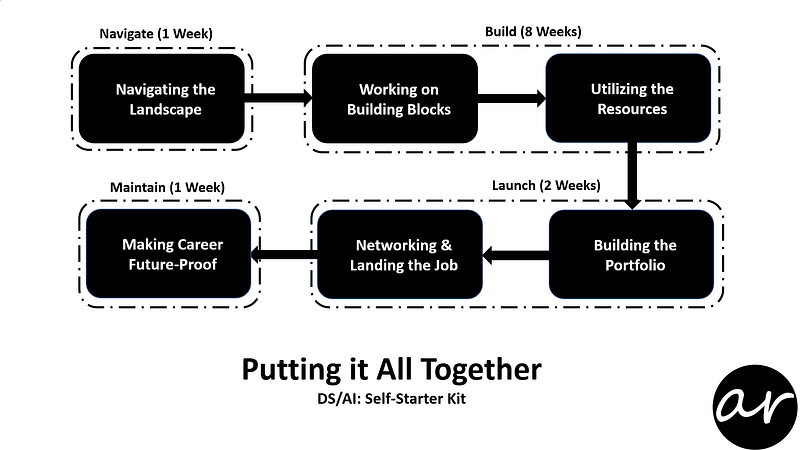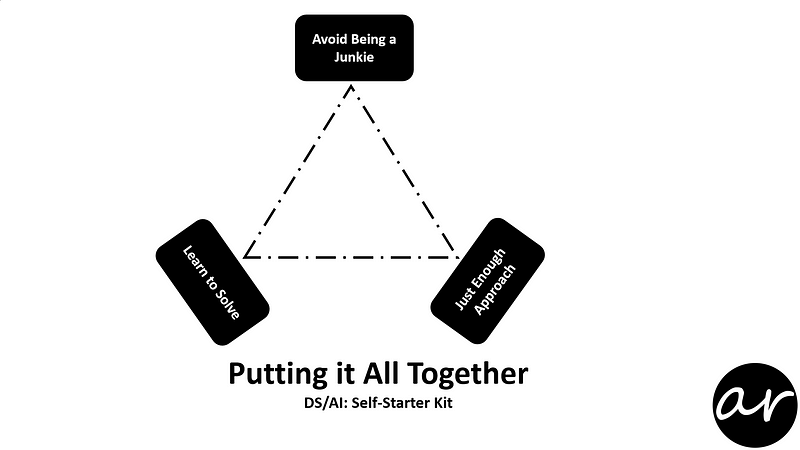| Previous | Table of Contents | Next |
Now that you have covered each and everything from the content perspective. Let’s reflect on what you have learnt and after that, I will give you few tips to overcome some learning obstacles.

You can notice that all these activities can be completed in 12 weeks.
As I mentioned earlier that you can not be an expert in ML/AI in such a short time but I can ensure that you have all the knowledge, concepts, processes and tools and techniques available to you to tackle any challenge in ML/AI.
After going through the ‘Navigate’ step, you need to focus as much as you can on building your skills in ‘Build’ step, you can start some of the activities of ‘Launch’ step in parallel as it would help you to grasp and apply what you learnt in ‘Build’ step.
On your path to learn and build your skill-set in ML/AI, you will find many obstacles. Some of them I am covering here and what you need to do to overcome those obstacles.

Avoid Being a Junkie
 on [Unsplash](https://unsplash.com/search/photos/junkyard?utm_source=unsplash&utm_medium=referral&utm_content=creditCopyText)](https://cdn-images-1.medium.com/max/800/1*uo6LTLuKcKwxC-3UC36GcQ.jpeg)
Online learning is like Chocolate. You can’t take just one online course or subscribe to just one newsletter/blog. Once you start, you want to have it all!
But the trouble with Chocolate is that, even if you eat the whole damn packet, you don’t have enough. The only thing that stops you is that the packet is empty, your stomach is full, and you feel kind of sick. But your appetite doesn’t really go away.
Similarly, having an unlimited access to all the online courses, MOOCs, webinars, workshops, challenges, e-books, blogs, TED talks, podcasts, and all the other free (or affordable) resources can get you in trouble.
The key to avoiding the trouble is to prioritize, plan, schedule and log what you do. And analyse at regular interval how your progress is and what is working while what needs to be improvised.
When you subscribe to a webinar or an online course, put it in your calendar. Set up reminders; make a commitment to attend it as if it was compulsory. In case of live events, if you can’t catch them live, schedule the time when you’re going to watch the replay. When you watch a webinar or an online course, don’t multitask. Close the door of your room, turn off your phone, and don’t open other tabs to check Twitter. After the webinar/course video ends, take several minutes to debrief. Find something you can put into practice right away and put it on your to-do list.
At the end of the month, evaluate. What have you learned? What worked? What didn’t?
Make a list of your favourite bloggers, podcasts, and other resources. Read them, listen to them or watch them as a part of your daily schedule. If you set aside time to do this, you will be able to concentrate on learning when you learn and to create when you create.
Learn to Solve
 on [Unsplash](https://unsplash.com/search/photos/solution?utm_source=unsplash&utm_medium=referral&utm_content=creditCopyText)](https://cdn-images-1.medium.com/max/800/1*90OqH2-MZ4cdAHmbOgStrQ.jpeg)
Learning is 20% information and 80% action.
If you aren’t taking action, you aren’t learning; you’re just wasting time. The key to making learning more effective is Active Learning.
According to a study into learning-centred approaches to education, students learn more when they participate in the process of learning. Active learning is discussion, practice, review, or application. Problem-solving, exploring new concepts in groups. Working out the problem on a piece of paper.
Active learning is any learning activity in which where you participate or interact with the learning process, as opposed to passively taking in the information.
When given the opportunity to actively engage with the information you are learning, you perform better. It nurtures the brain, giving it an extended opportunity to connect new and old information, correct previous misconceptions, and reconsider existing thoughts or opinions.
Active learning encourages your brain to activate cognitive and sensory networks, which helps process and store new information. One more similar research at Cornell University found that learner attention starts to wane every 10–20 minutes during lectures — which means instructors are continuously fighting to keep attention. Incorporating regular, varied active learning moments is a great solution to recapture an audience.
Similarly, when you are learning ML/AI theory, try to apply as soon as what you have learnt. This will keep you engaged and motivated for a longer period of time.
Just Enough Approach
 on [Unsplash](https://unsplash.com/search/photos/minimal?utm_source=unsplash&utm_medium=referral&utm_content=creditCopyText)](https://cdn-images-1.medium.com/max/800/1*97NI1gl1iL1gPBD0lAu-Zw.jpeg)
Just Enough Approach is learning just enough to perform a specific task. As we saw in the above sections that it does not help to be a course junkie. You need to learn in order to solve a problem. So don’t get into an endless learning loop and just learn enough to solve the problem at hand.
Unless you apply what you have learnt, there is no benefit of learning. And the depth in the theory of DS/AI is kind of endless, without any problem to solve, you may go as much deep as you want and still get no idea how to apply what you have learnt.
I always suggest my students to apply Just Enough Approach while learning DS/AI. This is the path of optimal learning, you learn the concept and solve the problem as well.
As we learnt in this post, there are few obstacles in the path of learning and application of ML/AI and you can overcome them by just being aware that they exist.
Conclusion
We have looked at the overall landscape, what are ML/AI terminologies and what are the roles in ML/AI projects. Then we worked on the building blocks by listing out what are the concepts, processes, and tools you need to learn. After that, we listed the resources we need to refer to during the learning stage.
Post that we learned how to build an impressive portfolio. How we can start building a network and prepare for the interview in order to search and land the job. Then we looked at the ways to make our career future-proof.
Now you have all the knowledge, concepts, processes & tools with you to tackle any challenge you face in ML/AI field.
I believe all the content provided in this series is helpful to you. If you liked (or not) the content, I would ask you to provide your feedback to me.
| Previous | Table of Contents | Next |